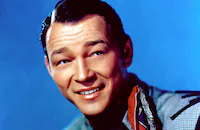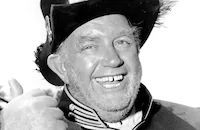On the Old Spanish Trail

Brief Synopsis
Cast & Crew
William Witney
Roy Rogers
Trigger
Tito Guizar
Jane Frazee
Andy Devine
Film Details
Technical Specs

Synopsis
When the sheriff arrives at the Great Southwestern Tent Show camped near Sioux City, Iowa, he tells performers The Sons of the Pioneers that a man named Burnett is coming to collect on their $10,000 loan, which was countersigned by local rancher and fellow entertainer, Roy Rogers. Burnett warns them that he will be forced to confiscate their show equipment if they cannot pay, but agrees to give them a few weeks in which to raise the money. Later, on a road outside of town, a suitcase falls from the top of a car driven by Candy Martin, a performer joining the show, and Roy soon comes across it. Candy returns to claim the case, just as Roy discovers a love poem from a gypsy named Ricco Perado and some photographs of Candy among the spilled contents. When she is not looking, Roy slips one of the photographs inside his shirt, but it is later stolen by Ricco. At the wagon where he lives, Ricco adds the photograph to the many already covering the walls, much to the annoyance of his sweetheart, Lola Gitana. She asks Ricco to leave town with her, showing him a Wanted poster with his description on it, but he refuses. Roy's sidekick, Cookie Bullfincher, then tells Roy about a $10,000 reward for the capture of a gypsy who has been robbing oil companies of their payroll funds. After Roy discovers that the Great Southwestern Tent Show was in the vicinity during each of the robberies, he decides to visit the show, hoping to capture the gypsy so that he can pay off the loan with the reward money. At the show, the real culprit in the oil company robberies, Harry Blaisdell, introduces Roy to Candy, who apologizes for being rude to him on the road. Later in Candy's dressing tent, Lola demands that Candy stay away from Ricco, but Candy explains she has never met the gypsy. When Candy later deduces that Ricco is the gypsy on the Wanted posters, she informs Roy, who chases him. Ricco dives into a river and swims away, followed by Roy. At a gypsy camp, Ricco is professing his innocence to his peers when shots are fired at him from the adjacent trees. Meanwhile, Lola kidnaps Candy and brings her to the camp as well. Harry and his men, who are themselves responsible for the oil company robberies, arrive at the camp and draw their guns. Although Ricco lassos one of Harry's men as he tries to escape, he is the one arrested by Cookie. Later, Harry and his men decide to free Ricco from jail while simultaneously committing another robbery, hoping that Roy and Cookie will then be convinced of Ricco's guilt. After Roy discovers Ricco missing from his cell and Candy tied up in his place, Ricco returns to explain what has happened. Convinced that he is an escaped prisoner, however, Roy takes him into custody. Later, Harry suggests that Roy and his men perform a mock hold-up in town to promote the show. Just as the "hold-up" is about to begin, Candy realizes that Harry is the leader of the outlaws, and Ricco tries to stop him from robbing the Inter-City Oil Company. The robbery is foiled and Cookie escapes with the cash boxes, as Roy leaps from his horse Trigger onto a moving carriage in an effort to catch the thieves. After Harry and his men are arrested, Candy opens the cash boxes and is shocked to find them empty. Meanwhile, Ricco returns to Lola with the stolen money, and the tent show moves on to its next venue.

Director
William Witney
Cast

Roy Rogers
Trigger
Tito Guizar

Jane Frazee

Andy Devine

Estelita Rodriguez

Charles Mcgraw
Fred Graham
Steve Darrell
Marshall Reed
Wheaton Chambers
Bob Nolan

Edward Keane
Bill Murphy
George "shug" Fisher
Edward Cassidy
Billy Mitchell
Crew
W. P. Blake
Earl Crain Sr.
Gaetano Donizetti
Ignacio Fernández Esperón
Gerald Geraghty
Pepe Guízar
Helen Hansard
Frank Hotaling
Jimmy Kennedy
Jack Lacey
Howard Lydecker
Theodore Lydecker
Bob Mark
Jack Marta
Tony Martinelli
Louise Massey
John Mccarthy Jr.
Sloan Nibley
Bob Nolan
Adele Palmer
Lee Penny
Felice Romani
Morton Scott
Kenneth L. Smith
Al Stewart
M. H. Sturgis
Edward J. White

Film Details
Technical Specs

Articles
On the Old Spanish Trail
Rogers was a big enough star at this point not to be threatened by the inclusion of his South of the Border counterpart in the cast. Tito Guizar was born in Guadalajara, Mexico, and as a boy trained as a singer over his father's objections. In 1929 he went to New York to make a recording of the hit songs of the famous Mexican composer Agustin Lara, and stayed on to study opera. By the mid-1930s, he was appearing at Carnegie Hall and made his film debut in Under the Pampas Moon (1935), a musical Western romance starring Warner Baxter of "Cisco Kid" fame. The following year he returned to Mexico and launched the Singing Cowboy movie trend in his native country, alternating between there and the U.S. over the next decade. In his later years, he continued working primarily in the Mexican film and television industry through 1998. Guizar died in 1999 at the age of 91.
In On the Old Spanish Trail, Guizar plays a Zorro-type character known as The Gypsy, a fugitive pursued by Roy Rogers seeking reward money to pay off a $10,000 loan he co-signed for the Sons of the Pioneers. But after capturing the alleged bandit, Roy realizes he's innocent and lets him go, catching up with the true criminals in time.
As well known as he was, Guizar did not get second billing in On the Old Spanish Trail. That honor went, as it usually did, to Rogers's famous horse, billed as Trigger, the Smartest Horse in the West. Missing from the cast was another frequent Rogers co-star, Dale Evans, who first appeared with him in 1945 and married Roy in 1947, a year after the death of his second-wife. The romantic interest in this movie is supplied instead by Jane Frazee in the second of five films she made with the cowboy. Tito Guizar also gets his own leading lady, a jealous "spitfire" named Lolita, played by Cuban-born Estelita Rodriguez, who appeared in eight other Rogers pictures between 1945 and 1951.
Another familiar face you won't see in On the Old Spanish Trail is George "Gabby" Hayes, Roy's comic sidekick in dozens of movies from 1939 to 1946. That job is taken in this film by Andy Devine, his third with Rogers. The villain is played by Charles McGraw, best known for his starring role in the film noir classic The Narrow Margin (1952).
On the Old Spanish Trail was released in theaters in Republic Pictures' Tru-Color process, but most of the prints seen on TV are from an edited black-and-white master.
The art director on this movie, Frank Hotaling, labored in B Westerns (including a number of Roy Rogers movies) for many years before moving up to John Ford productions, including The Searchers (1956) and The Quiet Man (1952), for which he received an Academy Award nomination.
Director: William Witney
Producer: Edward J. White
Screenplay: Sloan Nibley, story by Gerald Geraghty
Cinematography: Jack Marta
Editing: Tony Martinelli
Art Direction: Frank Hotaling
Cast: Roy Rogers (Roy Rogers), Trigger (Trigger), Tito Guizar (Rico/The Gypsy), Jane Frazee (Candy Martin), Andy Devine (Bullfincher), Estelita Rodriguez (Lolita), Charles McGraw (Harry Blaisdell).
BW-75m.
by Rob Nixon

On the Old Spanish Trail
Quotes
Trivia
Notes
The film's working titles were Heart of Mexico and Outlaws of Sioux City. The latter title was also a working title for Republic's Rustlers of Devil's Canyon (see below). Modern sources include Jack O'Shea in the cast.














